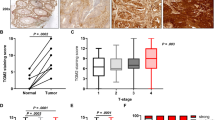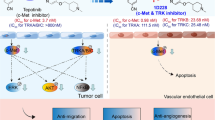Abstract
Administration of active TG2 to two different in vitro angiogenesis assays resulted in the accumulation of a complex extracellular matrix (ECM) leading to the suppression of endothelial tube formation without causing cell death. Matrix accumulation was accompanied by a decreased rate of ECM turnover, with increased resistance to matrix metalloproteinase-1. Intratumor injection of TG2 into mice bearing CT26 colon carcinoma tumors demonstrated a reduction in tumor growth, and in some cases tumor regression. In TG2 knockout mice, tumor progression was increased and survival rate reduced compared to wild-type mice. In wild-type mice, an increased presence of TG2 was detectable in the host tissue around the tumor. Analysis of CT26 tumors injected with TG2 revealed fibrotic-like tissue containing increased collagen, TG2-mediated crosslink and reduced organized vasculature. TG2-mediated modulation of cell behavior via changes in the ECM may provide a new approach to solid tumor therapy.
Similar content being viewed by others
Log in or create a free account to read this content
Gain free access to this article, as well as selected content from this journal and more on nature.com
or
Abbreviations
- TG2:
-
transglutaminase 2
- ECM:
-
extracellular matrix
- MMP:
-
matrix metalloproteinase
- HUVEC:
-
human umbilical large vein endothelial cells
- FCS:
-
fetal calf serum
- BSA:
-
bovine serum albumin
- vWF:
-
von Willebrand factor
- HRP:
-
horseradish peroxidase
- LDH:
-
lactate dehydrogenase
- TRITC:
-
tetramethyl rhodamine isothiocyanate
- FITC:
-
fluorescein isothiocyanate
- CBZ:
-
benzyloxycarbonyl
- EDTA:
-
ethylene diamine tetraacetic acid
- uPARAP:
-
urokinase plasminogen activator receptor-associated protein
References
Folkman J (1995) Angiogenesis in cancer, vascular, rheumatoid and other disease. Nat. Med. 1: 27–31
Brown PD and Giavazzi R (1995) Matrix metalloproteinase inhibition: a review of antitumor activity. Ann. Oncol. 6: 967–974
Griffioen AW, Tromp SC and Hillen HF (1998) Angiogenesis modulates the tumour immune response. Int. J. Exp. Pathol. 79: 363–368
Eisterer W, Jiang X, Bachelot T, Pawliuk R, Abramovich C, Leboulch P, Hogge D and Eaves C (2002) Unfulfilled promise of endostatin in a gene therapy-xenotransplant model of human acute lymphocytic leukemia. Mol. Ther. 5: 352–359
Korner G, Schneider DE, Purdon MA and Bjornsson TD (1989) Bovine aortic endothelial cell transglutaminase. Enzyme characterization and regulation of activity. Biochem. J. 262: 633–641
Lorand L and Graham RM (2003) Transglutaminases: cross-linking enzymes with pleiotropic functions. Nat. Rev. Mol. Cell Biol. 4: 140–156
Aeschlimann D and Thomazy V (2000) Protein cross-linking and remodeling of extracellular matrices: the role of transglutaminases. Connect. Tissue Res. 4: 1–27
Martinez J, Chalupowicz DG, Roush RK, Sheth A and Barsigian C (1994) Transglutaminase-mediated processing of fibronectin by endothelial cell monolayers. Biochemistry 33: 2538–2545
Johnson TS, Griffin M, Thomas GL, Skill J, Cox A, Yang B, Nicholas B, Birckbichler PJ, Muchaneta-Kubara C and Meguid El Nahas A (1997) The role of tansglutaminase in the rat subtotal nephroctomy model of renal fibrosis. J. Clin. Invest. 99: 2950–2960
Grenard P, Bresson-Hadni S, El Alaoui S, Chevallier M, Vuitton DA and Ricard-Blum S (2001) Transglutaminase-mediated cross-linking is involved in the stabilization of extracellular matrix in human liver fibrosis. J. Hepatol. 35: 367–375
Balklava Z, Verderio E, Collighan R, Gross S, Adams J and Griffin M (2002) Analysis of tissue transglutaminase function in the migration of swiss 3T3 fibroblasts. The active-state conformation of the enzyme does not affect cell motility but is important for its secretion. J. Biol. Chem. 277: 16567–16575
Jones RA, Nicholas B, Mian S, Davies PJ and Griffin M (1997) Reduced expression of tissue transglutaminase in a human endothelial cell line leads to changes in cell spreading, cell adhesion and reduced polymerisation of fibronectin. J. Cell Sci. 110: 2461–2472
Verderio EA, Telci D, Okoye A, Melino G and Griffin M (2003) A novel RGD-independent cell adhesion pathway mediated by fibronectin-bound tissue transglutaminase rescues cells from anoikis. J. Biol. Chem. 278: 42604–42614
De Laurenzi V and Melino G (2001) Gene disruption of tissue transglutaminase. Mol. Cell. Biol. 21: 148–155
Bell SE, Mavila A, Salazar R, Bayless KJ, Kanagala S, Maxwell SA and Davis GE (2001) Differential gene expression during capillary morphogenesis in 3D collagen matrices: regulated expression of genes involved in basement membrane matrix assembly, cell cycle progression, cellular differentiation and G-protein signaling. J. Cell Sci. 114: 2755–2773
Ingber DE (2002) Mechanical signaling and the cellular response to extracellular matrix in angiogenesis and cardiovascular physiology. Circ. Res. 91: 877–887
Haroon Z, Hettasch JM, Lai TS, Dewhirst M and Greenberg CS (1999) Tissue transglutaminase is expressed, active, and directly involved in rat dermal wound healing and angiogenesis. FASEB J. 13: 1787–1795
Haroon ZA, Lai TS, Hettasch JM, Lindberg RA, Dewhirst MW and Greenberg CS (1999) Tissue transglutaminase is expressed as a host response to tumor invasion and inhibits tumor growth. Lab. Invest. 79: 1679–1686
Gross SR, Balklava Z and Griffin M (2003) Importance of tissue transglutaminase in repair of extracellular matrices and cell death of dermal fibroblasts after exposure to a solarium ultraviolet A source. J. Invest. Dermatol. 121: 412–423
Nicholas B, Smethurst P, Verderio E, Jones RA and Griffin M (2003) Cross-linking of cellular proteins by tissue transglutaminase during necrotic cell death: a mechanism for maintaining tissue integrity. Biochem. J. 371: 413–422
Johnson TS, Skill NJ, El Nahas AM, Oldroyd SD, Thomas GL, Douthwaite JA, Haylor JL and Griffin M (1999) Transglutaminase transcription and antigen translocation in experimental renal scarring. J. Am. Soc. Nephrol. 10: 2146–2157
Verderio E, Gaudry C, Gross S, Smith C, Downes S and Griffin M (1999) Regulation of cell surface tissue transglutaminase: effects on matrix storage of latent transforming growth factor-beta binding protein-1. J. Histochem. Cytochem. 47: 1417–1432
Ingber D and Folkman J (1988) Inhibition of angiogenesis through modulation of collagen metabolism. Lab. Invest. 59: 44–51
Keogh J, Zirvi KA, Vossough S, Slomiany A and Slomiany BL (1993) Pharmacological alterations of cellular transglutaminase activity and invasiveness in human colorectal carcinoma cells. Cancer Biochem. Biophys. 13: 209–220
Johnson TS, Knight CR, el-Alaoui S, Mian S, Rees RC, Gentile V, Davies PJ and Griffin M (1994) Transfection of tissue transglutaminase into a highly malignant hamster fibrosarcoma leads to a reduced incidence of primary tumor growth. Oncogene 9: 2935–2942
Piacentini M, Piredda L, Starace DT, Annicchiarico-Petruzzelli M, Mattei M, Oliverio S, Farrace MG and Melino G (1996) Differential growth of N- and S-type human neuroblastoma cells xenografted into scid mice: correlation with apoptosis. J. Pathol. 180: 415–422
Dano K, Romer J, Nielsen BS, Bjorn S, Pyke C, Rygaard J and Lund LR (1999) Cancer invasion and tissue remodeling – cooperation of protease systems and cell types. APMIS 107: 120–127
Dvorak HF (1986) Tumors: wounds that do not heal. Similarities between tumor stroma generation and wound healing. N. Engl. J. Med. 315: 1650–1659
Mazooz G, Mehlaman T, Lai T-S, Greenberg CS, Dewhirst MW and Neeman M (2005) Development of magnetic resonance imaging contrast material for in vivo mapping of tissue transglutaminase activity. Cancer Res. 65: 1369–1375
Szondy Z, Sarang Z, Molnar P, Nemeth T, Piacentini M, Mastroberardino PG, Falasca L, Aeschlimann D, Kovacs J, Kiss I, Szegezdi E, Lakos G, Rajnavolgyi E, Birckbichler PJ, Melino G and Fesus L (2003) Transglutaminase 2−/− mice reveal a phagocytosis-associated crosstalk between macrophages and apoptotic cells. Proc. Natl. Acad. Sci. USA 100: 7812–7817
Skill NJ, Griffin M, El Nahas AM, Sanai T, Haylor JL, Fisher M, Jamie MF, Mould NN and Johnson TS (2001) Increases in renal ɛ(γ-glutamyl)-lysine cross-links result from compartment-specific changes in tissue transglutaminase in early experimental diabetic nephropathy: pathologic implications. Lab. Invest. 81: 705–716
LeBrasseur N (2005) Tumours feed on collagen. J. Cell Biol. 169: 835
Johnson TS, Haylor JL, Thomas GL, Fisher M and El Nahas AM (2002) Matrix metalloproteinases and their inhibitions in experimental renal scarring. Exp. Nephrol. 10: 182–195
Bishop ET, Bell GT, Bloor S, Broom IJ, Hendry NF and Wheatley DN (1999) An in vitro model of angiogenesis: basic features. Angiogenesis 3: 335–344
Leblanc A, Day N, Menard A and Keillor JW (1999) Protein guinea pig liver transglutaminase: a modified purification procedure affording enzyme with superior activity in greater yield. Expr. Purif. 17: 89–95
Freund KF, Doshi KP, Gaul SL, Claremon DA, Remy DC, Baldwin JJ, Pitzenberger SM and Stern AM (1994) Transglutaminase inhibition by 2-[(2-oxopropyl)thio]imidazolium derivatives: mechanism of factor XIIIa inactivation. Biochemistry 33: 10109–10119
Griffin M, Coutts IG and Saint RE (2004) Novel Compounds and Methods of Using the Same. International Publication No. WO2004/113363 A2
Baumgartner W, Golenhofen N, Weth A, Hiiragi T, Saint R, Griffin M and Drenckhahn D (2004) Role of transglutaminase 1 in stabilisation of intercellular junctions of the vascular endothelium. Histochem. Cell Biol. 122: 17–25
Mori M, Sadahira Y, Kawasaki S, Hayashi T, Notohara K and Awai M (1988) Capillary growth from reversed rat aortic segments cultured in collagen gel. Acta Pathol. JPN 38: 1503–1512
Knight CR, Rees RC and Griffin M (1991) Apoptosis: a potential role for cytosolic transglutaminase and its importance in tumour progression. Biochim. Biophys. Acta 1096: 312–318
Acknowledgements
This work has been supported in parts by grants from the EPSRC GR/S21755/01.
Author information
Authors and Affiliations
Corresponding author
Additional information
Edited by A Finazzi-Agrò
Rights and permissions
About this article
Cite this article
Jones, R., Kotsakis, P., Johnson, T. et al. Matrix changes induced by transglutaminase 2 lead to inhibition of angiogenesis and tumor growth. Cell Death Differ 13, 1442–1453 (2006). https://doi.org/10.1038/sj.cdd.4401816
Received:
Revised:
Accepted:
Published:
Issue date:
DOI: https://doi.org/10.1038/sj.cdd.4401816
Keywords
This article is cited by
-
Expression of transglutaminase-2 (TGM2) in the prognosis of female invasive breast cancer
BJC Reports (2024)
-
Cardiac fibrosis can be attenuated by blocking the activity of transglutaminase 2 using a selective small-molecule inhibitor
Cell Death & Disease (2018)
-
The functional relationship between transglutaminase 2 and transforming growth factor β1 in the regulation of angiogenesis and endothelial–mesenchymal transition
Cell Death & Disease (2017)
-
Transglutaminase-2: evolution from pedestrian protein to a promising therapeutic target
Amino Acids (2017)
-
Structural aspects of transglutaminase 2: functional, structural, and regulatory diversity
Apoptosis (2017)



